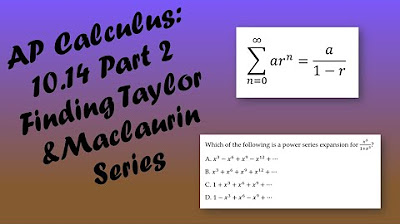Taylor and Maclaurin Series
TLDRThe video introduces Taylor and Maclaurin series, which are types of power series useful for representing functions. It explains how to derive the coefficients of these series using differentiation - the nth coefficient can be found by taking the nth derivative of the function and evaluating at a point. It shows that the Maclaurin series, a Taylor series expanded about 0, can neatly represent the exponential function. After defining key concepts, it notes applications but leaves detailed discussion for later. Overall it provides definitions and an overview of these important series to set the stage for more advanced analysis.
Takeaways
- 😀 A Taylor series is a type of power series where the coefficients are defined using derivatives of the function.
- 😊 A Maclaurin series is a special case of a Taylor series expanded about the point X = 0.
- 🧐 The coefficients of a Taylor series can be found using Cn = F^n(A)/n!, where F is the function.
- 😎 The coefficients of a Maclaurin series follow the same rule but with A = 0.
- 🤓 Taylor series allow approximating functions as power series with calculable coefficients.
- 😇 The radius of convergence determines the interval where the Taylor series approximation is valid.
- 🤔 The Maclaurin series approximation for e^x was shown to be an infinite series of x^n/n! terms.
- 👍 The ratio test can determine if a Taylor series converges - if ratio → 0, it converges.
- 😉 Taylor series concepts enable many useful calculus applications.
- 🥳 With Taylor/Maclaurin series covered, the calculus survey video course is complete.
Q & A
What is a power series?
-A power series is a series with terms in the form C_N x X^N, where C_N is a coefficient and X is a variable raised to the Nth power.
How can we find the coefficients C_N of a power series expansion?
-We can find the coefficients using derivatives. C_N = f^(N)(a) / N!, where f^(N) is the Nth derivative of the function f, and a is the point we are expanding about.
What is a Taylor series?
-A Taylor series is a power series expansion of a function f(x) about a point a. The coefficients C_N are found using derivatives of f(x) evaluated at the point a.
What is a Maclaurin series?
-A Maclaurin series is a special case of a Taylor series where the expansion is about the point x = 0.
Why are Taylor and Maclaurin series useful?
-These series allow us to represent complicated functions as infinite sums of terms. They have applications in approximation, evaluation, and integration of functions.
What is the radius of convergence?
-The radius of convergence determines the interval of x values for which the Taylor/Maclaurin series converges to the original function.
How do you find the radius of convergence?
-Use the ratio test - take the limit as N goes to infinity of |C_{N+1}/C_N|. If the limit is less than 1, the series converges.
What is the Maclaurin series for e^x?
-The Maclaurin series for e^x is 1 + x/1! + x^2/2! + x^3/3! + ..., which we obtained by taking derivatives of e^x and evaluating at 0.
What is the radius of convergence for the Maclaurin series of e^x ?
-For the Maclaurin series of e^x, the radius of convergence is infinite, meaning it converges for all x.
Where can Taylor and Maclaurin series be applied?
-These series have applications in polynomial approximation, evaluation of functions, integration and differentiation, solving differential equations, and more.
Outlines
📚 Defining Taylor and Maclaurin Series
This paragraph defines Taylor and Maclaurin series. A Taylor series is a power series expansion of a function centered around a point A. The coefficients are calculated using derivatives of the function evaluated at A. A Maclaurin series is a special case of a Taylor series expanded around the point X=0.
😀 Finding the Maclaurin Series for e^x
This paragraph shows an example of finding the Maclaurin series for the function f(x)=e^x. Using the fact that the nth derivative of e^x evaluated at 0 is 1, the series is easily derived to be the familiar exponential series. The ratio test shows the radius of convergence is infinity.
Mindmap
Keywords
💡Power series
💡Taylor series
💡Maclaurin series
💡Coefficients
💡Derivative
💡Radius of convergence
💡Factorial
💡Approximation
💡Exponential function
💡Convergence
Highlights
Taylor and Maclaurin series expand functions into an infinite series of terms involving powers of X.
The coefficients of a Taylor series are calculated using derivatives of the function evaluated at a point.
A Maclaurin series is a Taylor series expanded about X = 0.
The Taylor series formula allows us to expand functions into familiar power series forms.
The exponential function e^x has a simple Maclaurin series equal to the familiar infinite series representation.
The radius of convergence for the Maclaurin series of e^x is infinite, so it converges for all X.
Taylor series have many applications, but a full discussion is saved for later.
A power series has terms containing increasing powers of X with coefficients.
Plugging the point A into the original function isolates the first coefficient C0.
Taking derivatives and evaluating at A gives a method to calculate further coefficients.
The formula for the nth coefficient involves the nth derivative evaluated at A over n factorial.
Substituting the coefficient formula into a power series generates a Taylor series.
A Taylor series represents a function as an infinite sum of terms involving powers of X.
The series converges if X is within the radius of convergence around point A.
Understanding Taylor and Maclaurin series lays groundwork for more advanced calculus.
Transcripts
Browse More Related Video
5.0 / 5 (0 votes)
Thanks for rating:





